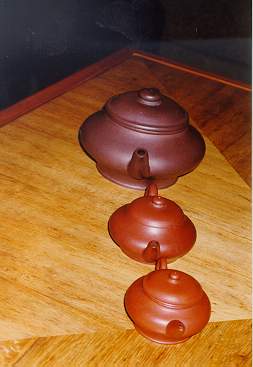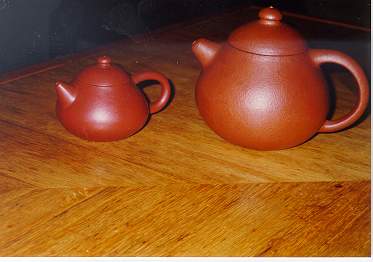...previous
page
The invention of the tea pot
The Ming dynasty (1368-1644) that followed the Yuan, in
reaction
to the Tartar invasion, tried to restore former Chinese ways in a
cultural
renaissance. The founder of the new dynasty, Chu Yuan-chang
(reigned 1368-1399)
was a man of humble origins who enjoyed drinking leaf tea and he
wished
to promote tea production by the state. In 1391 he decreed that
caked tea
should no longer be produced, and that all tribute tea should be
leaf tea.
The production of caked (brick) tea for the imperial court had
been a highly
complex and very expensive process, an extravagant source of
corruption
and waste. Once cake tea was no longer available, the ritual of
preparing
whisked tea from powdered tea was quickly abandoned. By 1487,
powdered
tea was only used by very conservative literati in a few regions.
At the
same time, the laws forbidding private production of tea that had
been
formulated in the early years of the new dynasty were rescinded
and tea
production flourished. Chinese society was becoming increasingly
commercial,
there were more and more wealthy people wishing to practice
cultivated
pursuits.
It was during the Ming dynasty that the method
of allowing the tea leaves
to soak (steep) in hot water for a time before drinking became
general.
This produces a transparent infusion, where powdered tea
contains the actual
leaves. The Ming aesthetes continued to look for the "true
flavour" of
tea, as before, by this new method. Writers praised the tea from
particular
sites, and recommended using the water from specific wells to
make them.
Every aspect of tea preparation became an object of
connoisseurship.
 In about 1500
the first teapots as we know them came into being, made at first
of unglazed
brown or red clay, the tiny, unglazed I-hsing "purple
sand" teapots
with their equally tiny cups that are still popular in southern
China and
Taiwan, and that are often used in Korea when Chinese tea is
being drunk.
The first person to have made teapots from this special clay of
I-hsing
is said to have been an unnamed monk from the nearby Chin-sha
Temple. From
him, Kung Ch'un, a young man who was a native of I-hsing,
learned the art,
at the start of the 16th century. While he was still young, Kung
Ch'un
became a servant in the household of Wu Lun (1440-1522),
also a native
of I-hsing and one of the leading tea masters of the age. Wu Lun
cultivated
a reclusive life among the hills and streams outside of the
city, but he
had many well-known friends whom he would sometimes visit in
Suchou. His
son passed the official metropolitan examinations in 1514 and
used to prepare
for the exams staying at Chin-sha Temple. This would be the time
when Kung
Ch'un learned the art of teapot making. The first teapots seem
to have
been rougher and larger than those popular later. During the
17th century
the art of clay teapots flourished but at the same time many
preferred
to use metal pots and cups.
In about 1500
the first teapots as we know them came into being, made at first
of unglazed
brown or red clay, the tiny, unglazed I-hsing "purple
sand" teapots
with their equally tiny cups that are still popular in southern
China and
Taiwan, and that are often used in Korea when Chinese tea is
being drunk.
The first person to have made teapots from this special clay of
I-hsing
is said to have been an unnamed monk from the nearby Chin-sha
Temple. From
him, Kung Ch'un, a young man who was a native of I-hsing,
learned the art,
at the start of the 16th century. While he was still young, Kung
Ch'un
became a servant in the household of Wu Lun (1440-1522),
also a native
of I-hsing and one of the leading tea masters of the age. Wu Lun
cultivated
a reclusive life among the hills and streams outside of the
city, but he
had many well-known friends whom he would sometimes visit in
Suchou. His
son passed the official metropolitan examinations in 1514 and
used to prepare
for the exams staying at Chin-sha Temple. This would be the time
when Kung
Ch'un learned the art of teapot making. The first teapots seem
to have
been rougher and larger than those popular later. During the
17th century
the art of clay teapots flourished but at the same time many
preferred
to use metal pots and cups.
During the later Ming, literati came to prefer
white porcelain for teacups,
since it allowed the colour of the tea to be admired. The art of
tea was
by this time virtually complete, and every true connoisseur had
his tea
room, located in an attractive spot near his library and study,
equipped
with beautiful utensils, often of considerable antiquity, where
he could
offer a variety of exquisite teas to his discerning friends.

Finally, in 1644, the Manchus invaded
China and took power as
the Quing dynasty, that continued until 1912. It was
only near the
start of their rule the tea makers discovered the secrets of
controlled
"fermentation" or oxidation of the leaves before and during the
drying
process, which gave birth to the immense variety of tastes found
in oolong
(lightly oxidized) and red (black) teas (much more
fully oxidized).
The new methods of making tea demanded a cup that would
emphasize the delicate
colour of the brew. This is why so many more recent tea cups are
white.
Click to go on to the next
page or back
to the Index
 In about 1500
the first teapots as we know them came into being, made at first
of unglazed
brown or red clay, the tiny, unglazed I-hsing "purple
sand" teapots
with their equally tiny cups that are still popular in southern
China and
Taiwan, and that are often used in Korea when Chinese tea is
being drunk.
The first person to have made teapots from this special clay of
I-hsing
is said to have been an unnamed monk from the nearby Chin-sha
Temple. From
him, Kung Ch'un, a young man who was a native of I-hsing,
learned the art,
at the start of the 16th century. While he was still young, Kung
Ch'un
became a servant in the household of Wu Lun (1440-1522),
also a native
of I-hsing and one of the leading tea masters of the age. Wu Lun
cultivated
a reclusive life among the hills and streams outside of the
city, but he
had many well-known friends whom he would sometimes visit in
Suchou. His
son passed the official metropolitan examinations in 1514 and
used to prepare
for the exams staying at Chin-sha Temple. This would be the time
when Kung
Ch'un learned the art of teapot making. The first teapots seem
to have
been rougher and larger than those popular later. During the
17th century
the art of clay teapots flourished but at the same time many
preferred
to use metal pots and cups.
In about 1500
the first teapots as we know them came into being, made at first
of unglazed
brown or red clay, the tiny, unglazed I-hsing "purple
sand" teapots
with their equally tiny cups that are still popular in southern
China and
Taiwan, and that are often used in Korea when Chinese tea is
being drunk.
The first person to have made teapots from this special clay of
I-hsing
is said to have been an unnamed monk from the nearby Chin-sha
Temple. From
him, Kung Ch'un, a young man who was a native of I-hsing,
learned the art,
at the start of the 16th century. While he was still young, Kung
Ch'un
became a servant in the household of Wu Lun (1440-1522),
also a native
of I-hsing and one of the leading tea masters of the age. Wu Lun
cultivated
a reclusive life among the hills and streams outside of the
city, but he
had many well-known friends whom he would sometimes visit in
Suchou. His
son passed the official metropolitan examinations in 1514 and
used to prepare
for the exams staying at Chin-sha Temple. This would be the time
when Kung
Ch'un learned the art of teapot making. The first teapots seem
to have
been rougher and larger than those popular later. During the
17th century
the art of clay teapots flourished but at the same time many
preferred
to use metal pots and cups.
